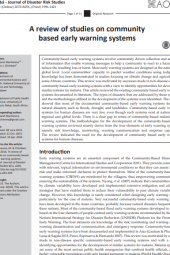A Review of Studies on Community Based Early Warning Systems
Summary
This article is a review of community-based early warning systems documented in the literature. The focus was on identifying the types of disasters addressed by these systems and the methodologies used in their development. The findings revealed that most documented community-based early warning systems primarily target natural disasters like floods, droughts, and landslides. Surprisingly, there is a scarcity of such systems for human diseases, despite their existence at national, regional, and global levels. Notably, there is a noticeable gap in community-based malaria early warning systems. The methodologies employed in developing these systems generally align with the four key elements of early warning systems, which include risk knowledge, monitoring, warning communication, and response capability. The review highlights the pressing need for the establishment of community-based early warning systems specifically designed for addressing human diseases.
Categories:
Report, Research Paper
Publisher:
Journal of Disaster Risk Studies
Published Year:
2016
